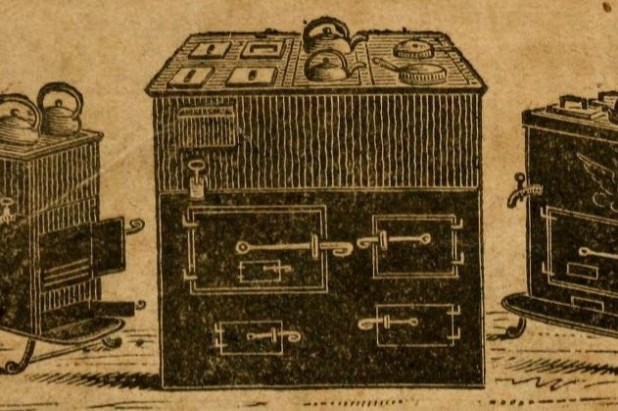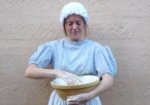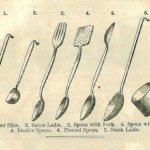The sweltering days we’ve had recently have put me in mind of a cook standing in front of a roaring open fire. So with that in mind, (drum-roll please) – it’s time to introduce “The most compact, clean, and best cooking apparatus in the whole world!”
At Elizabeth Farm we haven’t been lighting the kitchen fire of late as there have been fire bans in place [1], but usually you can walk in to that space and instantly realize that the role of the cook involved a lot of red faces, sweat and especially in summer considerable discomfort.
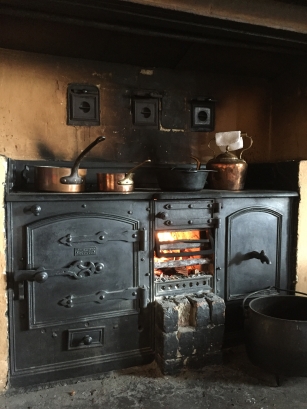
The Lasseter & Co kitchen range at Elizabeth Farm. Photo (c) Scott Hill for Sydney Living Museums
The receipts in the Macarthur archive give a vast amount of information as to daily life in the Parramatta household [2]. In 1826, for example, a substantial delivery of ironmongery – ranging from lampshades to hardware, and building materials to kitchen ware – arrived at Elizabeth Farm from London. These were actually ordered for another house altogether – a villa that was to planned be built on Macarthur’s estate of Pyrmont. Alongside hinges, nails, window glass, water closets and all sort of useful bits and pieces was an intriguingly titled object – a ‘steam oven’ [3].
This relates to an earlier request sent by John Macarthur to his son, John Jnr. in London, on 13th January 1824 – that’s exactly 194 years today as I write – for a “portable iron steam kitchen” for Elizabeth Farm. With the summer temperatures at Parramatta rising, the heat was high in John’s mind as he added it would be “a great relief to the poor cook in weather like this”. On these 38 degree days we can sympathise!
I wish you to send me a portable iron steam kitchen – of a good size. Such a thing will be a great relief to the poor cook in weather like this. Some of your Society friends will tell you where the best constructed are to be bought. They used to be some admirable ones displayed in Holborne?
As it is rather bulky article you must look out to get it on board some ship nearly full – in these cases they will sometimes take a light bulky article cheap. The kitchen I mean contains an apparatus for baking boiling… roasting &c and for heating water in an adjoining bath.
By the end of the letter though he had characteristically changed his mind and quickly and dramatically added –
I have just learnt that Patent Kitchens are to be bought here under prime [?] cost. The measures of the Govt have reduced the inhabitants to the necessity of leaving off eating consequently [rest unclear]. Kitchens are unsaleable. Don’t do anything on the purchase of one until my next! [3]
Things are bad if people give off eating! Regardless of his oscillating requests, two years later some form of steam-heated kitchen apparatus was unloaded on the docks in Sydney, recorded in an invoice as “1 best improved Patent Kitchen range oven & steam boiler, cock &c complete – L:16.16.0” [Excerpt from invoice for Ironmongery received from I.J Evans, No. 1 Fish Street Hill, 1826]
“…[A] great relief to the poor cook in weather like this”.
We know who Macarthur’s ‘poor cook’ was – the young (in 1826) 21-year old Thomas Blake; a convict assigned to the household the previous year and described as fair complexioned, hazel eyed and with light brown hair. He had been sentenced to transportation for life (a pretty standard sentence that typically lasted 7 years), and must have been quickly snapped up by Macarthur as he had been a bread and biscuit baker in his former life! Likely he baked in the oven we’ve previously looked at.
‘Neither fatiguing nor offending the delicacy of the nicest lady…’
We’ve previously talked about cooking technology, open fires and ranges, and the difference between ‘baking’ and ‘roasting’. But what was a ‘steam kitchen’, and how did it actually work? It’s all about how the heat is transferred from the burning fuel to the foodstuff being cooked: with ‘roasting’ it was by direct radiation from the fire to the meat hung adjacent to it; To cook a foodstuff by boiling (often just poaching) you placed it in water, which was then heated by direct contact to the fire below it, or via the metal ‘cook-top’ surface if an iron range was being used.
As the Industrial Revolution accelerated in the early 1800s technology was developing rapidly, and kitchen technology wasn’t left behind. The new steam kitchens followed on from the earlier development of Count Rumford’s designs, which included enclosed boilers to capture heat and produce a steady supply of hot water.
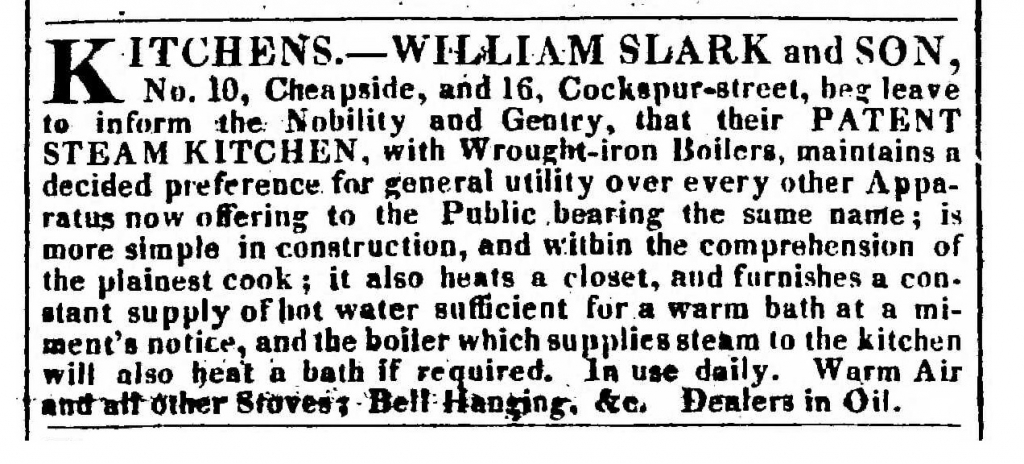
William Slark & Son advertisement for steam kitchens. London Morning Post, April 30th 1824, p1. Source Newspaper Archive
“The most compact, clean, and best cooking apparatus in the whole world!”
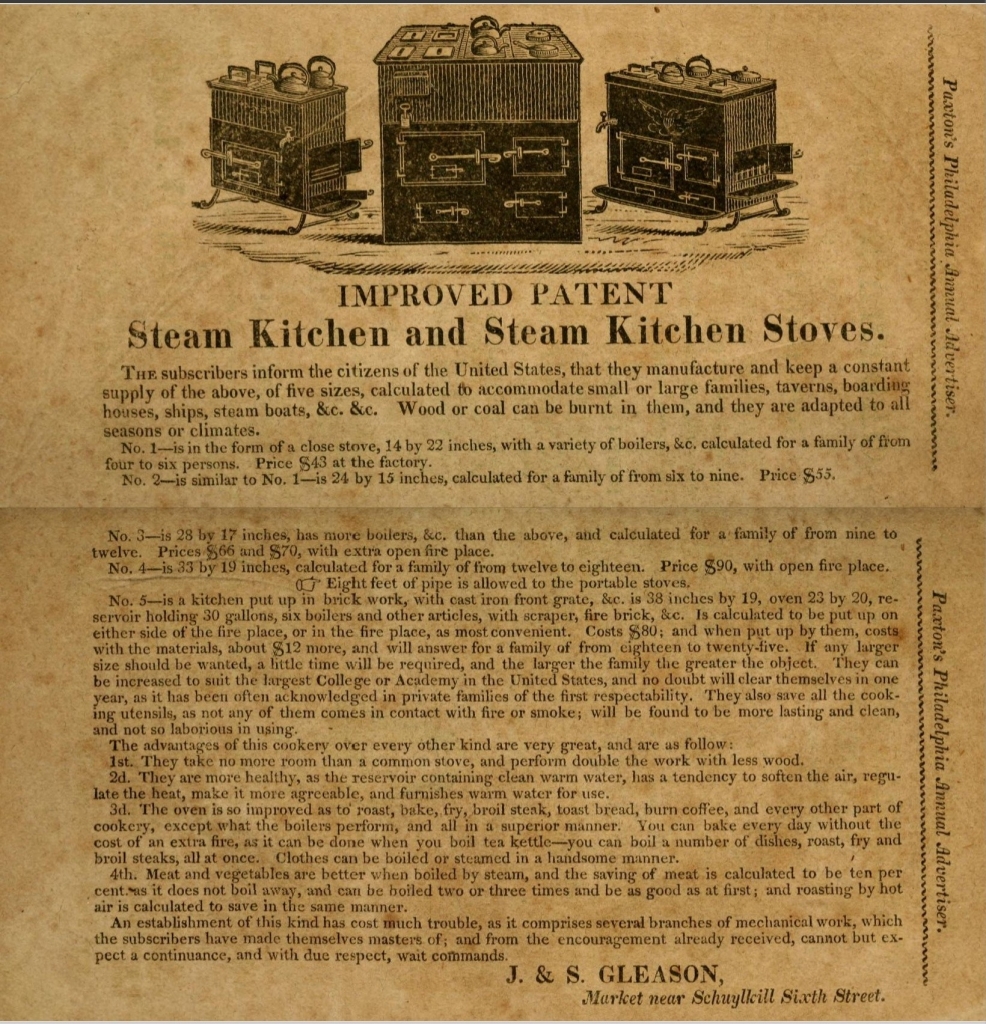
Advertisement for steam kitchens from ‘Paxton’s Philadelphia Annual Advertiser’ in 1819.
With this design of range however an enclosed boiler produced and captured the steam – if you’ve ever scalded your hand in the steam from a kettle you’ll know how hot it is, after all water boils at 100 degrees. The steam was then piped into enclosed compartments, the surfaces of which then became extremely hot, with recesses on the top into which pots were placed. Think of it being almost like a bain-marie in any takeaway, but steam-heated rather than using a hot water ‘bath’, and quite hot enough to cook in. If you look at the image below, from an 1819 American advertisement, you’ll see that the cooking pots and kettles seem to be purpose-shaped to fit snugly into the recesses. Heat then transferred directly from surface to surface. There were variations; one simpler version seems to be a flat top onto which pots were simply placed. On the left you can see the larger door to a steam-heated oven:
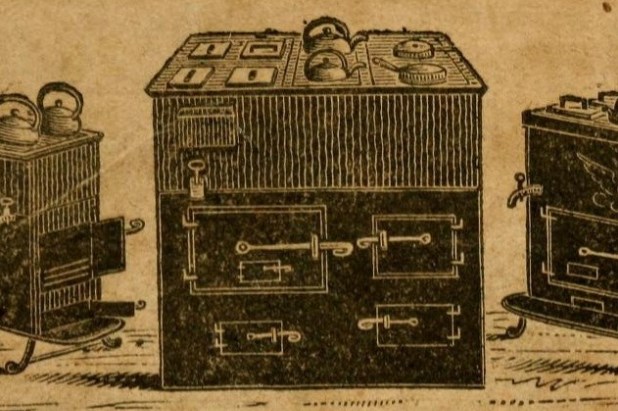
Detail of an advertisement for steam kitchens from Paxtons Philadelphia Annual Advertiser, 1819.
The 1910 edition of the Encyclopaedia Brittanica (Edinburgh, Andrew Bell, 1810. Vol XIX, pp678-9) records: ´
If, therefore, a boiler be properly fitted up in a furnace, and if the steam of the water boiling in it be conveyed by a pipe into a pan containing victuals to be dressed, everything can be cooked that requires no higher degree of heat than that of boiling water: And this will be done without any risk of scorching, or any kind of overheating, which frequently spoils our dishes, and proceeds from the burning heat of air coming to those parts of the pot or pan which is not filled with liquor, and is covered only with a film, which quickly burns and taints the whole dish.
Paralleling Macarthur’s concerns for their cook, it added:
Nor will the cook be scorched by the great heat of the open fire that is necessary for dressing at once a number of dishes, nor have his person and clothes foiled by the smoke and foot unavoidable in the cooking on an open fire. Indeed the whole process is so neat, so manageable, so open to inspection, and so cleanly, that it need neither fatigue nor offend the delicacy of the nicest lady.
Well no-one likes to be fatigued or offended!
So where is it now?
Well that’s a good question. Presumably some form of steam-heated apparatus duly arrived, and, with the villa at Pyrmont abandoned not long after construction started, was possibly installed during the renovations that made Elizabeth Farm a constant building site from 1826 till 1829. I suspect that if installed it may have worked happily for some years, before developing a fault or breaking down, and, being unable to be repaired so far from the manufacturer, was removed and sold for scrap. Or another possibility: in the July 1848 auction catalogue for Vineyard, Hannibal Macarthur’s house across the Parramatta River, there was a “steam cooking apparatus” listed – could this have been it? One day we may discover its fate. When, later in the 19th century, the house was leased a tenant complained that there was no kitchen range at all in the kitchen. The one we see today, the Lasseter & Co. range pictured above, was only added by the Swanns after they bought the house!
While the Macarthurs’ range is an early and likely the first reference to a steam kitchen arriving in New South Wales, advertisements soon appeared from local retailers so we know at least a few of them were also in circulation. This example, from 1834, follows the standard language seen in steam kitchen ads around the world:
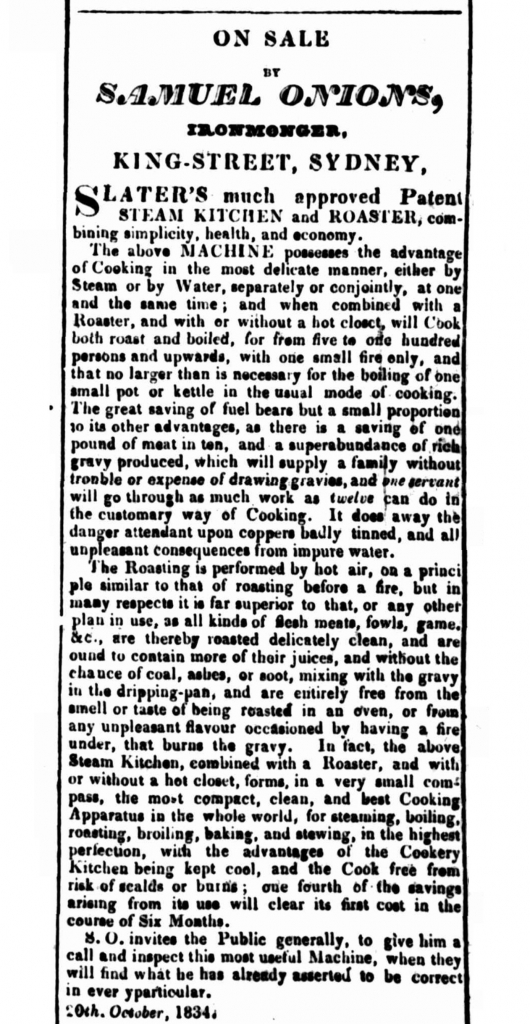
Samuel Onions advertisement for steam kitchens. The Sydney Gazette, 16 Dec. 1834. Source: Trove Newspapers Online
Despite its much-lauded properties, the steam kitchen never caught on and two decades later was already disappearing. It was expensive, and the multitude of conventional – and far cheaper – coal or wood-fired ranges were soon seen all around the globe. Steam power, of course, changed the world for ever.
Notes
[1] If you’re reading this overseas you may wonder what a ‘fire ban’ is; they’re a routine part of life in Australia. Basically they’re put in force when temperatures (and things like wind speed, humidity and lack of rain) have risen to a point where a bush fire is highly likely. Open fires are banned to lessen the risk of sparks or embers starting a fire.
[2] Today Elizabeth Farm sits in the suburb of Harris Park; when the house was first built, the area was known to the Macarthurs as ‘Rose Hill’ (after George Rose, Secretary to the British Treasury) and encompassed what in mid-1791 was renamed Parramatta – the name derived from that of the indigenous Burramattagal people. Read more at the Dictionary of Sydney.
[3] ‘Invoice of ironmongery &c. from I.J Evans, No. 1 Fish Street Hill’. From John Macarthur, Receipted Bills 1824-26. ML A3002, State Library of NSW.
[4] John Macarthur to John Macarthur Jnr. 31st January 1824. John Macarthur – letters to his sons 1815-1832; ML A2899. SLNSW
